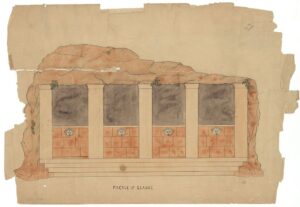[6] ἑτέραν δὲ ἐκ τῆς ἀγορᾶς τὴν ἐπὶ Σικυῶνα ἐρχομένοις ἔστιν ἰδεῖν ἐν δεξιᾷ τῆς ὁδοῦ ναὸς καὶ ἄγαλμα χαλκοῦν Ἀπόλλωνος καὶ ὀλίγον ἀπωτέρω κρήνη καλουμένη Γλαύκης: ἐς γὰρ ταύτην ἔρριψεν αὑτήν, ὡς λέγουσι, τῶν Μηδείας ἔσεσθαι φαρμάκων τὸ ὕδωρ νομίζουσα ἴαμα. ὑπὲρ ταύτην πεποίηται τὴν κρήνην καὶ τὸ καλούμενον Ὠιδεῖον, παρὰ δὲ αὐτὸ μνῆμά ἐστι τοῖς Μηδείας παισίν: ὧν ὀνόματα μέν σφισι Μέρμερος καὶ Φέρης, καταλιθωθῆναι δὲ ὑπὸ Κορινθίων λέγονται τῶν δώρων ἕνεκα ὧν τῇ Γλαύκῃ κομίσαι φασὶν αὐτούς:
- Map
- Pre Reading
- Post Reading
- Culture Essay
Returning to the agora and heading west, Pausanias visits monuments that commemorate Medea and her family in Corinth. The first is the fountain named after Creon’s daughter Glauce because she threw herself into the water here to obtain relief from the poisonous dress given her as a wedding gift by Medea. The same sites offer Pausanias a chance to comment on how older religious rites have been abandoned by the new Roman settlers. Finally, mention of Medea, who at one time ruled in Corinth, leads Pausanias to continue his discussion of history begun at the beginning of Book 2 with a fuller account of the history of the kings of Corinth from Helios to Cypselus.
N/A
[pods name=”culture_essay” slug=”medea-crosser-of-boundaries-draft” field=”post_title”]
[pods name=”culture_essay” slug=”medea-crosser-of-boundaries-draft” field=”essay_excerpt”]

